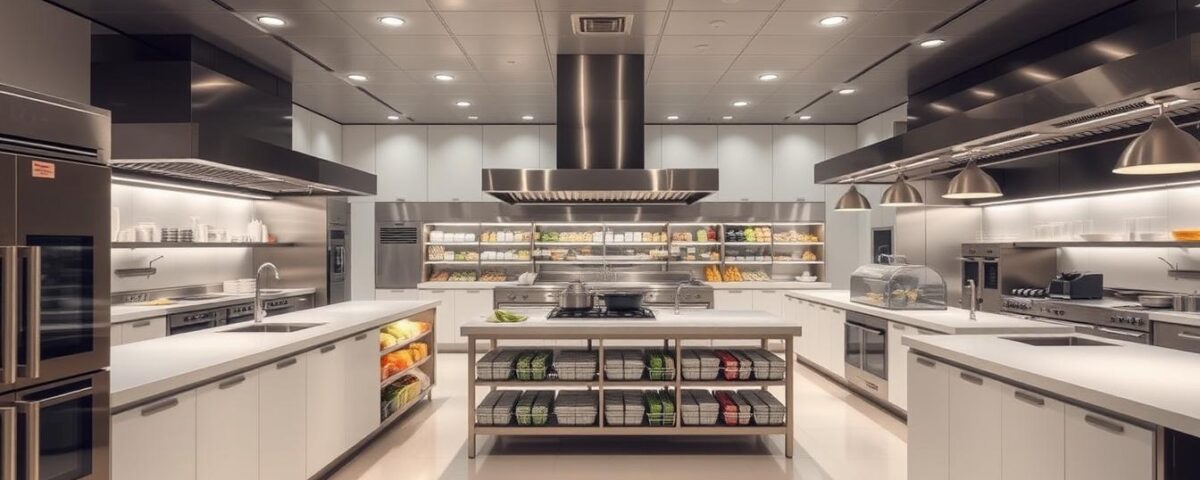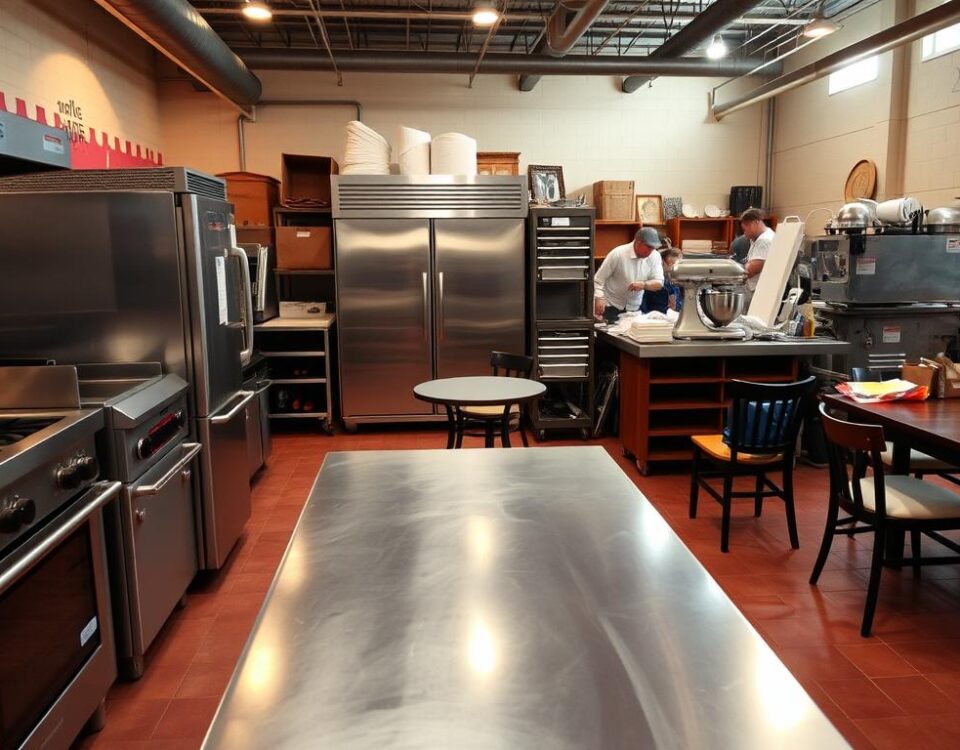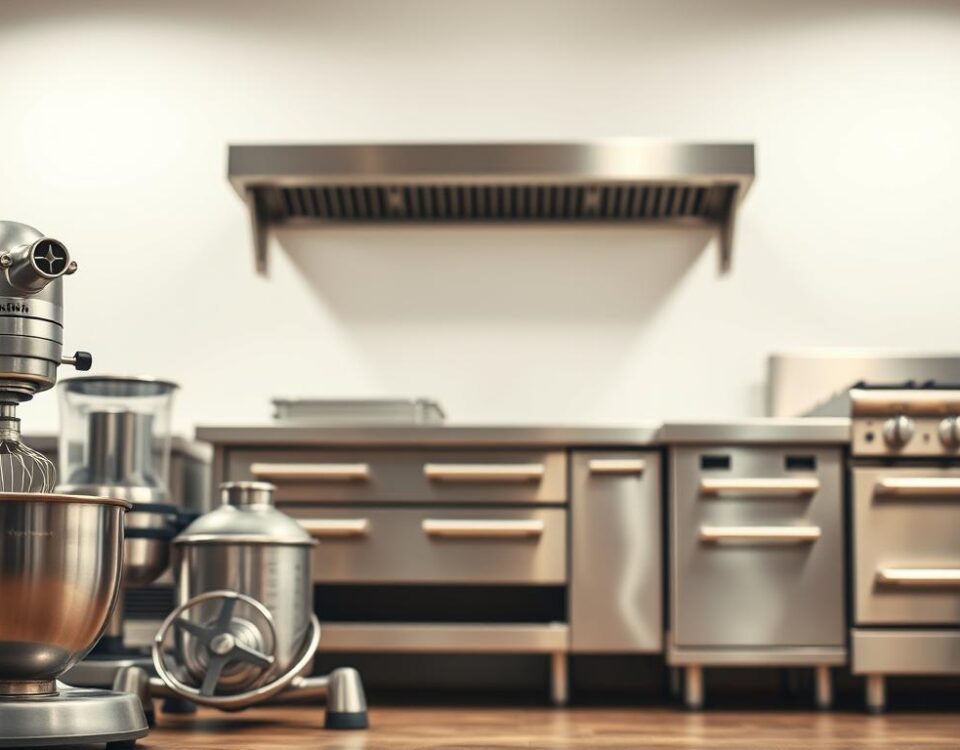
Restaurant Not Getting Enough Traffic? Location Could Be the Problem
June 22, 2025
Eco-Friendly Chef Tools That Actually Work—Top Picks for 2025
June 23, 2025I still remember the day a local restaurant owner told me about the incredible success she had with her ghost kitchen, a commercial cooking space dedicated solely to preparing food for delivery and takeout.
Her story isn’t unique; the food industry is witnessing a significant shift towards ghost kitchens, with a surprising 300% growth in the past two years alone.
This boom is driven by changing consumer preferences and technological advancements, making ghost kitchens an attractive option for entrepreneurs and restaurant owners alike.
As the delivery-focused business model continues to gain traction, it’s clear that ghost kitchens are here to stay.
Key Takeaways
- The ghost kitchen concept is revolutionizing the food industry.
- Ghost kitchens operate without traditional dining spaces, focusing on delivery and takeout.
- The growth of ghost kitchens is driven by consumer preferences and technology.
- Lower overhead costs and higher profit potential make ghost kitchens attractive.
- Ghost kitchens are becoming increasingly popular among restaurant owners and entrepreneurs.
What Are Ghost Kitchens?
The concept of ghost kitchens has revolutionized the food industry, offering a new paradigm for restaurants and food delivery services. Essentially, ghost kitchens are cooking facilities that produce food solely for delivery or takeout, eliminating the need for a physical dining space.
Definition and Concept
Ghost kitchens operate without traditional dine-in spaces or customer-facing storefronts, focusing on preparing and packaging meals for delivery. They leverage online platforms to receive and manage orders, streamlining the food delivery process. This model allows for greater flexibility and efficiency in food preparation, as kitchens can be optimized for production without the constraints of a traditional restaurant layout.
The ghost kitchen concept has gained popularity due to its ability to reduce operational costs associated with maintaining a dine-in restaurant. By eliminating the need for a storefront, ghost kitchens can allocate more resources to food quality and delivery logistics.
Alternative Names: Virtual Kitchens, Cloud Kitchens, Dark Kitchens
Ghost kitchens are also known by other names, including virtual kitchens, cloud kitchens, and dark kitchens. While these terms are often used interchangeably, subtle differences exist. For instance, virtual kitchens typically refer to kitchens that exist solely online, without a physical cooking location. Cloud kitchens, on the other hand, may involve a shared kitchen space where multiple vendors operate.
The Evolution of Ghost Kitchens Through 2025
The concept of ghost kitchens began to emerge around 2013, but it wasn’t until the pandemic that they gained widespread acceptance. As restaurants sought ways to continue operations during lockdowns, ghost kitchens provided a viable solution. The global ghost kitchen market is projected to grow from $71.14 billion in 2023 to approximately $157.26 billion by 2030, reflecting a compound annual growth rate (CAGR) of 12%.
| Year | Market Size (Billion) | CAGR |
|---|---|---|
| 2023 | $71.14 | – |
| 2030 | $157.26 | 12% |
Understanding the Ghost Kitchen Business Model
By eliminating the need for a physical dining space, the ghost kitchen business model offers a cost-effective solution for food businesses. This model has gained popularity due to its ability to reduce overhead costs and increase profit margins.
Key Components of the Model
The ghost kitchen business model consists of several key components, including a commercial kitchen facility, online ordering systems, delivery logistics, and digital marketing. These elements work together to enable efficient food preparation and delivery.
- A commercial kitchen facility equipped for food preparation
- Online ordering systems to manage customer orders
- Delivery logistics to ensure timely food delivery
- Digital marketing strategies to promote the business
How Ghost Kitchens Differ from Traditional Restaurants
Ghost kitchens differ significantly from traditional restaurants in several ways. The most notable difference is the lack of a physical dining space, which reduces overhead costs associated with rent, decor, and front-of-house staff.
| Characteristics | Ghost Kitchens | Traditional Restaurants |
|---|---|---|
| Dining Space | No | Yes |
| Overhead Costs | Lower | Higher |
| Staffing Requirements | Less staff | More staff |
Revenue Streams and Profit Potential
Ghost kitchens can generate revenue through various channels, including direct orders through proprietary websites and third-party delivery platforms. By reducing overhead costs, ghost kitchens can achieve higher profit margins compared to traditional restaurants.
According to recent data, traditional restaurants have average profit margins of 2-5%. In contrast, ghost kitchens can unlock an additional 5% or more in profit due to lower overhead costs.
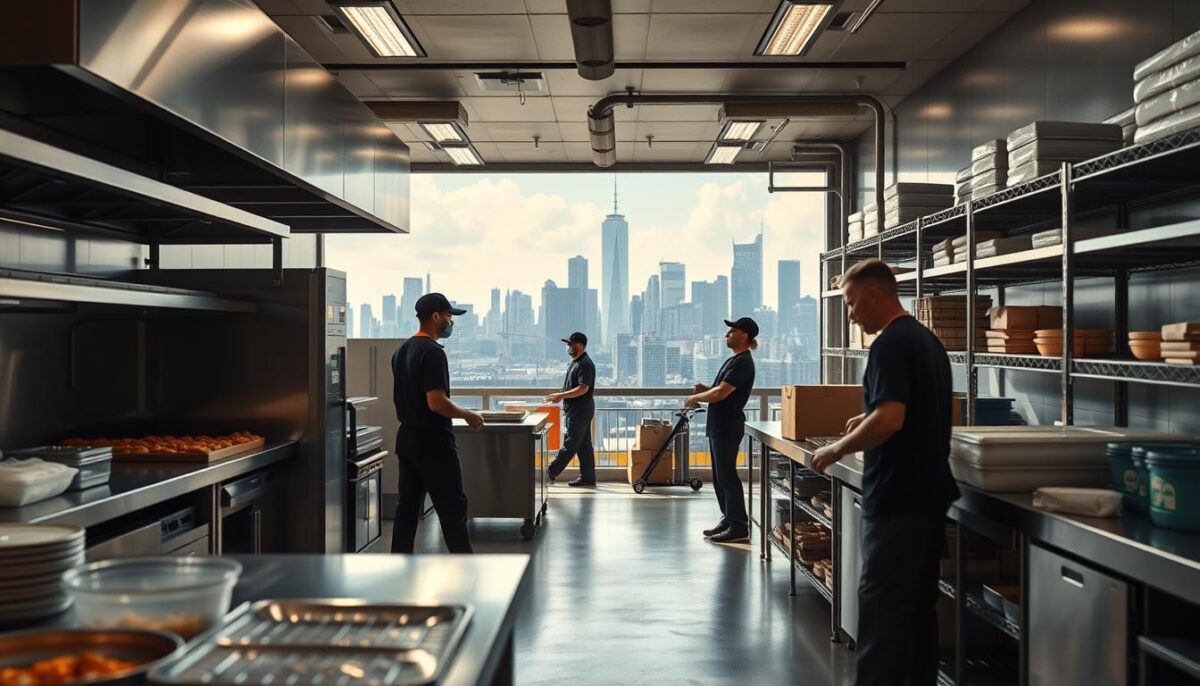
Types of Ghost Kitchen Business Models
The rise of ghost kitchens has led to the development of different business models, each with its unique advantages. These models cater to various entrepreneurs and businesses, providing flexibility and opportunities for growth in the food industry.
Independent Ghost Kitchens
Independent ghost kitchens are owned and operated by individual restaurateurs or chefs. This model allows for complete control over branding, menu pricing, and profit margins. Entrepreneurs can maintain their unique identity and cater to their target audience without any external influence.
For instance, a chef can open an independent ghost kitchen to offer a new cuisine or concept, leveraging their existing brand reputation or creating a new one.
Shared or Commissary Kitchens
Shared or commissary kitchens involve multiple food businesses operating from a single, fully-equipped kitchen. This model is cost-effective, as businesses can share resources and split costs. It’s an ideal option for new entrepreneurs or those looking to test new concepts without significant upfront investments.
Companies like Kitchen United offer shared kitchen spaces, providing access to commercial-grade equipment and licensed facilities.
Restaurant Conversion Models
Existing brick-and-mortar restaurants can convert their kitchens into ghost kitchens to operate secondary delivery-only brands. This model allows restaurants to maximize their existing kitchen space and cater to the growing demand for food delivery.
By doing so, restaurants can expand their customer base and increase revenue without significant additional investments.
Third-Party Ghost Kitchen Facilities
Third-party ghost kitchen providers like CloudKitchens offer ready-to-use kitchen spaces with built-in services. This model is beneficial for businesses looking for a hassle-free entry into the ghost kitchen market. Providers handle the infrastructure, allowing businesses to focus on their core operations.
These facilities often come equipped with commercial-grade equipment and technology, making it easier for businesses to get started.

Each of these models differs in terms of startup costs, operational control, scalability, and profit potential. By understanding the unique characteristics of each model, entrepreneurs can choose the best fit for their business goals and resources.
Why Ghost Kitchens Are Booming in 2025
The ghost kitchen business model is gaining traction in 2025 due to several key factors. As the food delivery service industry continues to grow, ghost kitchens are well-positioned to capitalize on this trend.
Lower Overhead Costs and Startup Investment
One major advantage of ghost kitchens is their lower overhead costs and reduced startup investment. By eliminating the need for dining areas and front-of-house staff, ghost kitchens can significantly reduce their expenses. This makes it easier for entrepreneurs to enter the market and for existing businesses to expand their operations.
Changing Consumer Preferences Post-Pandemic
Consumer preferences have shifted dramatically post-pandemic, with a continued emphasis on convenience and food delivery options. The food delivery service industry has grown over 52% since the pandemic’s start, and this trend shows no signs of slowing down. Ghost kitchens are perfectly positioned to meet this demand, offering a wide range of cuisines and dining options to customers.
Technology and Delivery App Integration
Technology has played a crucial role in the growth of ghost kitchens, particularly through the integration of delivery apps. Platforms like Uber Eats have seen significant growth, with revenue increasing by 100% year over year in 2020. This integration makes it easier for customers to discover and order from ghost kitchens, driving sales and revenue.
Market Growth Statistics and Projections
The market growth statistics for ghost kitchens are impressive, with the industry expected to increase by 10.3% year-over-year between 2023 and 2030. The following table highlights some key statistics and projections for the ghost kitchen industry:
| Year | Industry Growth Rate | Delivery Orders Growth Rate |
|---|---|---|
| 2020 | 52% (since pandemic start) | 70% (year-over-year) |
| 2023-2030 | 10.3% (year-over-year) | N/A |
These statistics demonstrate the significant expansion and future potential of the ghost kitchen industry, making it an attractive option for entrepreneurs and investors alike.
Setting Up Your Ghost Kitchen Business
Launching a ghost kitchen business involves several key steps that can make or break your venture. To ensure success, it’s crucial to understand the foundational elements required to get started.
Market Research and Concept Development
To begin, conducting thorough market research is essential. This involves identifying opportunities and gaps in the local food delivery market. By understanding consumer preferences and trends, you can develop a unique concept for your ghost kitchen business, including cuisine selection, brand identity, and target audience definition.
Legal Requirements and Permits
Understanding the legal requirements and permits needed to operate a ghost kitchen is vital. This includes food service licenses, health inspection permits, and business licenses. It’s crucial to check local state and city regulations to ensure compliance with all necessary requirements.
Securing a Commercial Kitchen Space
Securing an appropriate commercial kitchen space is a critical step. This can be achieved by leasing a dedicated facility, partnering with a commissary kitchen, or utilizing third-party ghost kitchen providers. The average cost to open a single ghost kitchen location ranges from $20,000 to $60,000.
Equipment and Technology Needs

Outfitting your ghost kitchen with the right equipment and technology is essential for efficient operations. This includes cooking appliances, food storage solutions, packaging materials, and digital ordering systems. By investing in the right tools, you can streamline your workflow and improve customer satisfaction.
By carefully planning and executing these key steps, you can establish a successful ghost kitchen business that meets the demands of the modern food delivery market.
Creating a Successful Ghost Kitchen Menu
To thrive in the competitive ghost kitchen market, a thoughtful menu strategy is essential. A well-crafted menu not only attracts customers but also ensures operational efficiency and profitability.
Designing Delivery-Friendly Food Items
Ghost kitchens must prioritize menu items that are designed to travel well. This means opting for dishes that maintain their flavor, texture, and presentation during transit. Examples include burgers, sandwiches, grain bowls, and certain fried items that retain their crispiness.
Menu Optimization Strategies
To optimize your menu, keep it focused and streamlined to improve operational efficiency and reduce food waste. Cross-utilizing ingredients across multiple dishes can lower inventory costs while maintaining menu variety. This approach also simplifies inventory management and reduces the complexity of kitchen operations.
Packaging Solutions for Food Quality
Effective packaging is crucial for preserving food quality during delivery. Consider using compostable containers, insulated packaging for hot meals, and spill-proof designs. Branding your packaging with logos, QR codes, or thank-you notes can enhance customer engagement and retention. When selecting packaging solutions, balance the costs with the perceived value by the customer.
Pricing strategies should balance competitiveness with profitability, taking into account food costs, packaging expenses, and delivery fees. By carefully designing your menu and packaging, you can create a compelling offering that attracts and retains customers in the competitive ghost kitchen market.
Technology and Operations for Ghost Kitchens
The success of a ghost kitchen hinges on its ability to leverage technology for seamless operations and customer satisfaction. By integrating the right technological tools, ghost kitchens can streamline their operations, from order management to delivery logistics.
POS and Online Ordering Systems
A seamless online ordering and POS system is essential for managing orders efficiently in a ghost kitchen. Implementing robust POS and online ordering systems that integrate with multiple delivery platforms centralizes order management, ensuring smoother operations.
Cloud-based POS systems can sync with third-party delivery services, kitchen printers, and analytics dashboards, thereby streamlining operations and enhancing customer experience.
Delivery Logistics and Management
Ghost kitchens must decide between self-delivery and third-party delivery services. Each approach has its pros and cons, and the choice depends on the kitchen’s operational capabilities and customer reach.
Using order tracking systems to provide real-time updates to customers enhances their experience and builds trust. Technology also helps manage peak order times, ensuring timely preparation and delivery.
Kitchen Workflow Optimization
Optimizing kitchen workflow is crucial for efficient operations. Strategies include implementing dedicated prep stations, automated kitchen display systems, and efficient packaging stations.
Best practices for inventory management and supply chain optimization help maintain consistent food quality and minimize waste, further enhancing customer satisfaction.
Marketing Your Ghost Kitchen Business
In the competitive world of ghost kitchens, a well-planned marketing strategy is crucial for standing out and achieving success. As a ghost kitchen owner, leveraging digital marketing and optimizing your presence on delivery platforms can significantly boost your visibility and customer base.
Digital Marketing Strategies
Effective digital marketing is key to attracting customers to your ghost kitchen. This includes social media marketing, email campaigns, and search engine optimization (SEO). Creating a mobile-friendly website with online ordering capabilities and customer reviews can build trust and encourage repeat business. Utilizing platforms like Instagram, TikTok, and Facebook to showcase your food and share behind-the-scenes content can also engage potential customers.
| Marketing Channel | Benefits |
|---|---|
| Social Media | Engage customers, share updates, and promote offers |
| Email Campaigns | Notify customers about new menu items and promotions |
| SEO | Improve search engine rankings and visibility |
Building Your Brand Without a Storefront
Building a strong brand without a physical storefront requires a consistent visual identity, compelling storytelling, and quality packaging. Your brand’s story and values should resonate with your target audience, creating an emotional connection that fosters loyalty. Quality packaging not only ensures that your food arrives in good condition but also serves as a tangible representation of your brand.
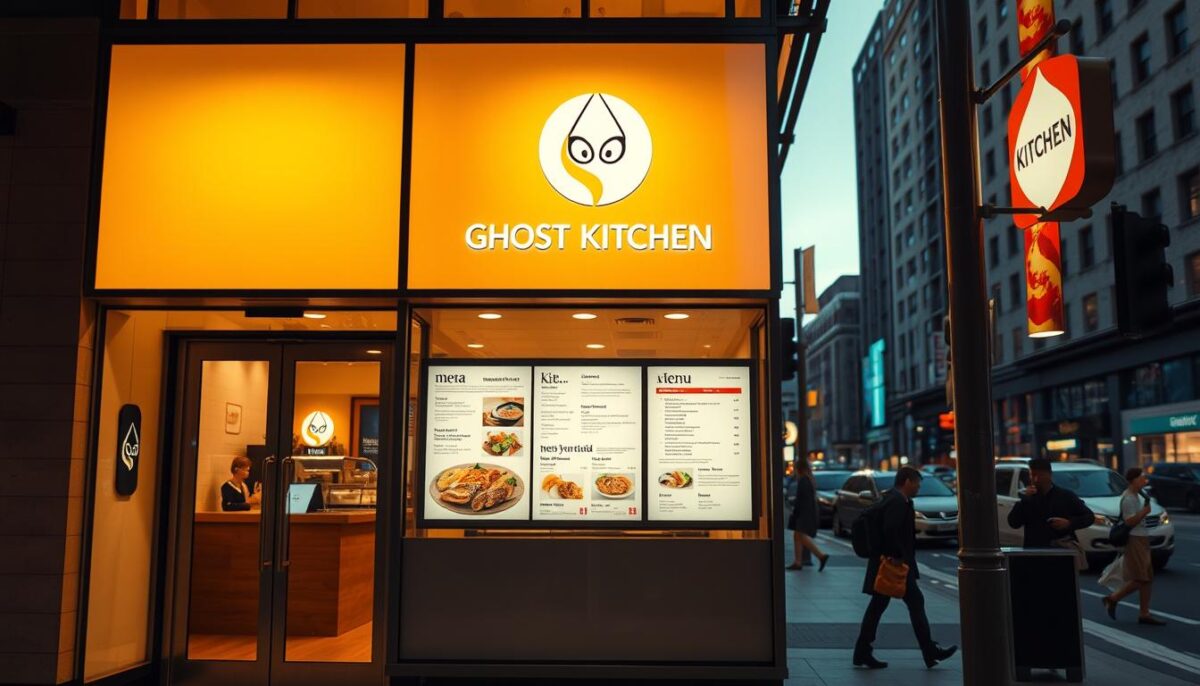
Leveraging Delivery Platforms for Visibility
Optimizing your listings on delivery platforms is crucial for improving visibility and attracting new customers. Ensure that your menu is presented clearly, and your brand is consistently represented across all platforms. Encouraging customers to leave positive reviews can significantly enhance your reputation and attract more customers.
By implementing these strategies, ghost kitchen businesses can effectively market themselves, build a strong brand presence, and drive customer engagement.
Challenges and Solutions in the Ghost Kitchen Model
As the ghost kitchen model continues to gain popularity, it’s essential to address the challenges that come with this innovative business approach. Ghost kitchens, by their nature, lack a physical storefront, which can lead to difficulties in building brand awareness and customer loyalty.
Common Obstacles Ghost Kitchens Face
Ghost kitchens encounter several challenges, including limited customer interaction, brand visibility issues, and dependence on third-party delivery platforms. The lack of face-to-face interaction can make it difficult to build personal connections with customers and foster a sense of community.
| Challenge | Impact | Potential Solution |
|---|---|---|
| Limited customer interaction | Reduced brand loyalty | Personalized digital communication |
| Dependence on delivery platforms | High commission fees | Develop direct ordering channels |
| Brand visibility issues | Difficulty in attracting new customers | Invest in digital marketing strategies |
Strategies to Overcome Delivery Challenges
To overcome delivery challenges, ghost kitchens can implement quality control measures, optimize packaging for different food types, and manage delivery timing effectively. Negotiating better terms with third-party delivery services and diversifying platform partnerships can also help mitigate the impact of commission fees.
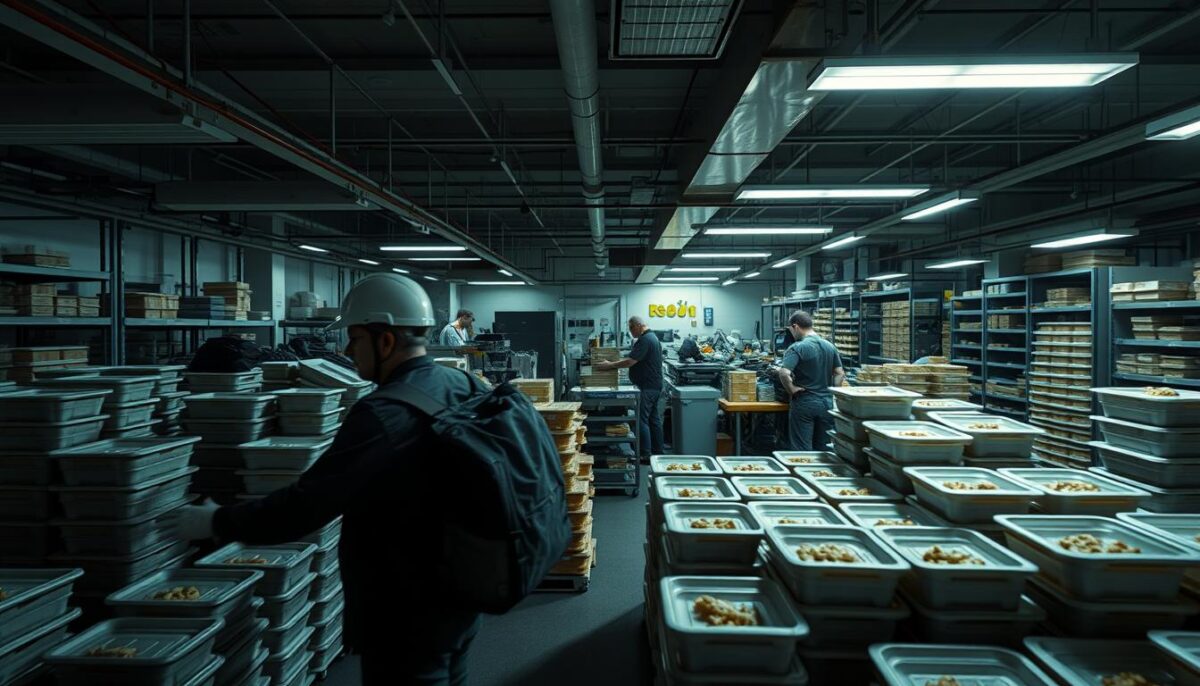
Building Customer Loyalty Without Face-to-Face Interaction
Building customer loyalty in a ghost kitchen model requires consistent food quality, personalized digital communication, and memorable packaging. By leveraging customer data and feedback, ghost kitchens can continuously improve operations and enhance the customer experience, fostering loyalty despite the lack of face-to-face interaction.
Conclusion: The Future of Ghost Kitchens Beyond 2025
As we look beyond 2025, the ghost kitchen business model is poised to revolutionize the food service industry. The key points discussed throughout this article highlight the growing popularity of ghost kitchens due to their efficiency and cost-effectiveness. Emerging trends such as automation, AI-driven operations, and sustainable practices will shape the future of ghost kitchens. While challenges like increased competition and evolving consumer preferences lie ahead, adaptability and innovation will be crucial for long-term success. The ghost kitchen model represents a significant shift in the food service industry, offering opportunities for entrepreneurs to leverage this trend and achieve their business goals.
FAQ
What is the primary advantage of a virtual kitchen over a traditional restaurant?
The primary advantage is lower overhead costs, as virtual kitchens don’t require a storefront or dining area, reducing expenses like rent and staffing.
How do ghost kitchens handle customer service?
I rely on digital marketing strategies and delivery platforms to interact with customers, gather feedback, and build brand loyalty, even without face-to-face interaction.
What kind of food is best suited for a ghost kitchen?
Delivery-friendly food items that are easy to transport and maintain quality during shipping work best, such as bowls, wraps, or dishes that can be reheated.
Can an existing restaurant convert to a ghost kitchen?
Yes, many existing restaurants are adopting the ghost kitchen concept to increase order volume and expand their customer base by leveraging delivery apps.
How do ghost kitchens manage their online presence?
I focus on social media and online ordering systems to create a strong online brand, engage with customers, and drive sales through various digital channels.
What are the key components of a successful ghost kitchen operation?
Efficient kitchen workflow, reliable delivery logistics, and optimized menu items are crucial to a successful ghost kitchen, ensuring high-quality food and a seamless customer experience.
How do ghost kitchens compete with established brands?
By offering competitive menu pricing, high-quality food, and convenient delivery options, ghost kitchens can attract new customers and build a loyal following.
